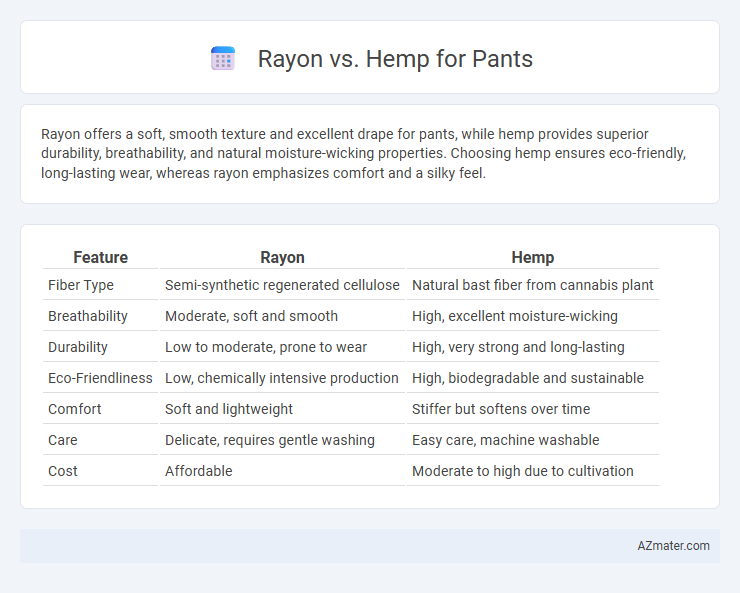Rayon offers a soft, smooth texture and excellent drape for pants, while hemp provides superior durability, breathability, and natural moisture-wicking properties. Choosing hemp ensures eco-friendly, long-lasting wear, whereas rayon emphasizes comfort and a silky feel.
Table of Comparison
| Feature | Rayon | Hemp |
|---|---|---|
| Fiber Type | Semi-synthetic regenerated cellulose | Natural bast fiber from cannabis plant |
| Breathability | Moderate, soft and smooth | High, excellent moisture-wicking |
| Durability | Low to moderate, prone to wear | High, very strong and long-lasting |
| Eco-Friendliness | Low, chemically intensive production | High, biodegradable and sustainable |
| Comfort | Soft and lightweight | Stiffer but softens over time |
| Care | Delicate, requires gentle washing | Easy care, machine washable |
| Cost | Affordable | Moderate to high due to cultivation |
Introduction to Rayon and Hemp Fabrics
Rayon is a semi-synthetic fiber made from regenerated cellulose, primarily derived from wood pulp, offering a silky texture and excellent breathability ideal for lightweight pants. Hemp is a natural fiber sourced from the cannabis plant, known for its durability, moisture-wicking properties, and resistance to UV rays, making it suitable for sturdy, eco-friendly trousers. Both fabrics provide unique benefits in comfort and sustainability, influencing the choice of material based on functionality and environmental impact.
Sustainability: Rayon vs Hemp
Hemp is significantly more sustainable than rayon due to its natural growth process requiring minimal water, pesticides, and fertilizers, making it an eco-friendly fiber choice. Rayon production involves chemically intensive processing and generates environmental pollutants, impacting water sources and ecosystems. Hemp's biodegradability and carbon sequestration qualities further enhance its sustainability profile for pants manufacturing.
Comfort and Breathability Comparison
Hemp pants offer superior breathability due to their natural fiber structure, which promotes airflow and moisture-wicking, making them ideal for warm climates. Rayon, a semi-synthetic fiber derived from cellulose, provides a softer and smoother texture against the skin, enhancing comfort but may lack the same moisture management as hemp. Choosing between hemp and rayon for pants depends on prioritizing natural breathability or silky comfort for everyday wear.
Durability and Longevity in Pants
Hemp fibers offer superior durability and longevity compared to rayon when used in pants, due to hemp's natural resistance to wear and tear and its high tensile strength. Rayon, being a semi-synthetic fiber derived from cellulose, tends to break down faster, especially with frequent washing and prolonged exposure to moisture. Choosing hemp pants ensures a longer-lasting garment that maintains its structural integrity over time, making it a more sustainable and cost-effective option for durable apparel.
Moisture-Wicking Properties
Hemp fabric offers superior moisture-wicking properties compared to rayon, drawing moisture away from the skin while maintaining breathability and quick-drying capabilities. Rayon, derived from cellulose fibers, tends to absorb moisture but lacks the breathability to effectively wick sweat, making it less suitable for active or humid conditions. Hemp's natural antimicrobial qualities also prevent odor buildup, enhancing comfort and freshness in pants designed for extended wear.
Hypoallergenic Qualities for Sensitive Skin
Hemp fibers are naturally hypoallergenic and antimicrobial, making them an excellent choice for pants worn by individuals with sensitive skin or allergies. Rayon, derived from cellulose, can also be soft and breathable but often undergoes chemical processing that may cause irritation in sensitive skin types. Hemp's durability and moisture-wicking properties enhance comfort while minimizing skin reactions, positioning it as a superior fabric for hypoallergenic pants.
Environmental Impact of Production
Rayon production relies heavily on chemical-intensive processes and large quantities of water, contributing to pollution and deforestation due to its dependence on wood pulp from fast-growing trees. Hemp cultivation requires fewer pesticides and less water, promoting soil health and carbon sequestration, making it a more sustainable fiber choice for pants. The environmental footprint of hemp is significantly lower than rayon, which involves energy-intensive manufacturing with toxic byproducts.
Style and Texture Differences
Rayon pants offer a smooth, silky texture with excellent drape, lending a polished and elegant style ideal for formal or office wear. Hemp fabric delivers a coarser, more textured feel with natural irregularities that create a rugged, casual appearance suited for everyday or eco-conscious fashion. The breathable quality of hemp contrasts with the sheen and softness of rayon, influencing both the garment's aesthetic and comfort level.
Care and Maintenance Requirements
Rayon pants require gentle washing with cold water and mild detergent to prevent shrinking and maintain fabric softness, often needing air drying to avoid damage. Hemp pants are more durable with less stringent care, tolerating machine washing and frequent use without significant wear, while becoming softer over time. Regular maintenance for both fabrics includes avoiding bleach and ironing on low heat to preserve fiber integrity and color vibrancy.
Cost and Accessibility for Consumers
Rayon pants generally offer a more affordable price point compared to hemp due to lower production costs and widespread manufacturing infrastructure, making them accessible to a broad range of consumers. Hemp fabric tends to be pricier because of its sustainable cultivation practices and limited processing facilities, resulting in a higher retail cost. Consumers seeking budget-friendly options often gravitate toward rayon, while those prioritizing eco-friendly materials may invest more in hemp pants despite the cost difference.

Infographic: Rayon vs Hemp for Pants
 azmater.com
azmater.com